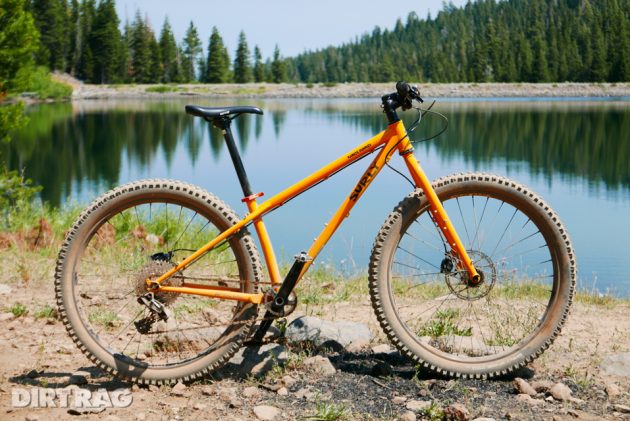First Ride: Surly Karate Monkey 27plus
Originally posted on August 5, 2016 at 7:00 am
Ed note: This is part of our initial bike test of three new hardtails introduced at QBP Saddle Drive 2016, each shod with 27plus tires: the aluminum Salsa Timberjack, carbon Salsa Woodsmoke and steel Surly Karate Monkey. Despite their obvious differences, we will draw some comparisons and distinctions among the three, so make sure to check out the other first ride reviews, too.

In case you’ve been under a rock for the last decade or so, a primer: The Surly Karate Monkey was one of the first production 29ers on the market. Surly bikes are not the fastest, lightest, newest, fanciest or most technically whiz-bang on the market. That’s probably why I like ’em so much (have to admit my bias, here). When I start to feel like I’m just being aggressively and excessively marketed to as an editor in the cycling industry, I take a break and ride my Surly. To be fair, I also own a modern carbon full-suspension trail bike that I adore, but I wear the mantle of steel-loving retrogrouch much better.

The new Monkey is slacker and longer. It sports a 69-degree headtube angle (formerly 72 degrees), a slightly shorter chainstay length, a wheelbase stretched by about an inch and a longer top tube. Seat tube angle is the same. The seat tube diameter bumps up to 30.9 for greater dropper-post compatibility while the frame comes stock with Surly Dirt Wizard 27.5×3.0 tires. I’m nuts for Dirt Wizards, especially since they were updated to be less tear-prone. They have grip, grip, grip for days.

Whereas the old Monkey was either rigid or built with a 100 mm fork, the new one will take up to a 140 mm fork. A 140 will raise the bottom bracket 17 mm and kick the headtube angle out to 67.5 degrees. The frame is loaded with even more braze-ons than ever. Yessiree, this is intended to be a bikepacker, a rigid singlespeed, a cross-country bike or a trail shredder. Or, all of the above. Choose your own adventure. Choose all of the adventures.

The new Monkey made me smile. It’s not better or worse than the two Salsa’s I also test rode at Saddle Drive: the carbon Woodsmoke and aluminum Timberjack. In fact, those other mid-travel 27plus bikes outshine the Monkey on several points. For $600 more (OK, yes, that’s a lot) you can get in on a carbon Woodsmoke with suspension or, for the same price as the Monkey, grab the Timberjack and get suspension.
Surly’s entry in this category is just different. If you want a plus hardtail, you have to find the one that suits your riding style and calms your inner demons. The Karate Monkey is my drug of choice. I would probably build it just like this Surly employee did. No, yes, this is exactly what I’d do.
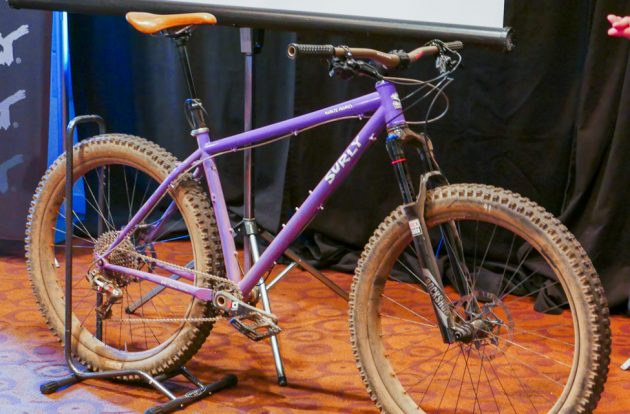
Anyway, how does it ride? It rides like a Surly. The Monkey is still made of the company’s 4130 ‘Natch chromoly steel, but with slightly bigger tubing than previously used on this bike. It doesn’t have internal cable routing or weird tubing shapes. It’s not light but it’s mighty comfortable. Get off my lawn.
One of the Surly guys said the company strives for balance with its bikes. It didn’t try to do stuff like make the rear chainstays as short as possible just for the sake of making them as short as possible. The Monkey is intended to ride well in a multitude of situations, not just one or two. And that it does.
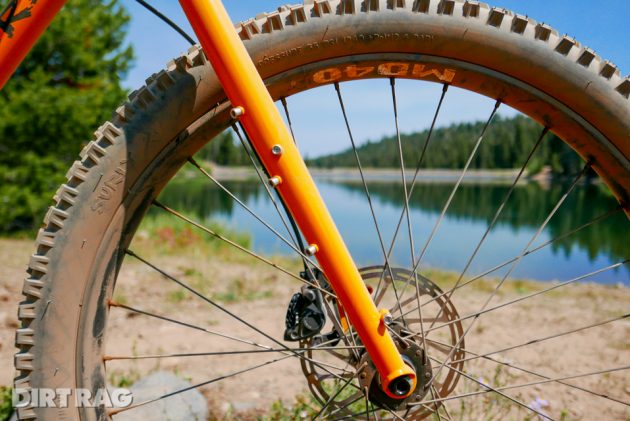
The bike is extraordinarily stable, almost to a fault if you’re intending to play. It’s not as flickable as some other bikes but rather trucks along with confidence, those big meats digging in all the way. To that end, it climbed far better than I expected. In fact, on the ride up the dirt service road, I kept looking around to see if I had a tailwind. No such luck. (I’m not very strong but I had just downed two shots of espresso; maybe that had something to do with it?) I caught up to two dealers also riding the Monkey who made the same comment: “This thing climbs really well!”
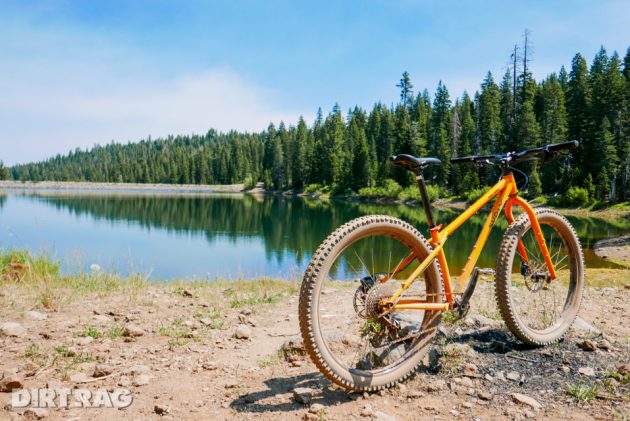
On flat to rolling singletrack, the Monkey felt a little sluggish. It’s weight and big tires means it’s a bit slow to get up to speed. The bike also doesn’t hold its momentum as well as other options. I felt that I was working it harder than the aluminum Timberjack and carbon Woodsmoke that I also sampled that same day on the same route in the hills of Northstar at Tahoe. Yes, those bikes have lighter frames. Still, if I were looking for a single hardtail that’s versatile, reasonably priced, comfortable and fun, I’d pick this one.
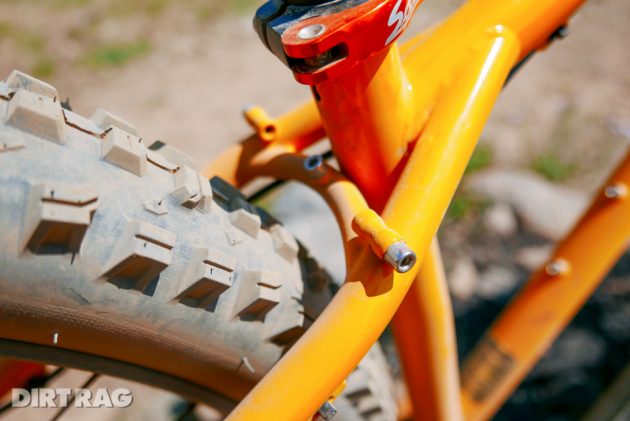
On the way down, the Monkey is a blast. I would have loved to have tried out a version with a suspension fork; I can image the addition of some squish would make this bike truly shine. I plowed it along the same intermediate DH trails I tested the other plus hardtails on and it held its own, rigid fork and all. It confidently led me down slow, techy sections that required taking it more carefully but was also just as happy being pushed hard through the chunk. With the help of the big tires, it hugged the dusty berms, despite being not as easy to throw around.

Some on the interwebs have called this a 27plus Krampus. Not so. The geometry numbers aren’t even close. The Monkey is more like a slimmed-down Surly Wednesday (read our full test of that bike), from which this frame borrows some tricks. One of them is a proprietary dropout called Gnot-Boost that offers spacing of 145 mm, allowing the steel frame to expand to fit 148 mm Boost hubs or pulled inward to work with a 142 mm hub. Surly is also now offering an add-on that allows you to transform the rear track dropouts to standard, vertical dropouts.
True to being a Surly, this thing is so versatile that I’m just going to send you to the Monkey’s homepage rather than trying to detail all the details, here.

The stock bikes are orange (geared/frame) for $1,400 complete, purple (singlespeed/frame) for $1,175 complete and black (frame only). Frame/fork can be had for $600. On the 1×11 geared version you get SRAM NX components, an 11-42 cassette, SRAM Level brakes, an Answer Pro Taper handlebar and a WTB Volt saddle (note that not all of that is pictured; the demo bikes at this event had different builds). The singlespeed will run 30×17 gearing. Go nuts.
